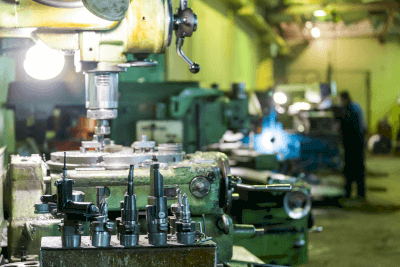What Is Boring Machinery?

Boring machinery is a machine tool specialized for a process called boring.
Boring is the process of enlarging a hole drilled with a drill, etc., by expanding the hole. Boring is used to make larger holes that cannot be drilled, or when accurate dimensioning and finishing are required.
Boring can be performed on milling machines, machining centers, and turret lathes, but boring machinery is often used when machining large workpieces or when boring deep holes. The tools used are called “boring bars,” and there are a wide variety of types, including those that can handle deep holes and those made of cemented carbide.
Uses of Boring Machinery
Boring machines are used for boring workpieces that cannot be machined with other machine tools, such as lathes and machining centers.
For example, a lathe can only process workpieces that can be grasped by the spindle chuck. Even if the spindle chuck can grasp the workpiece, it will not be able to machine it if there is any interference when the boring bar is moved closer to the workpiece.
Similarly, machining centers are limited in the size of workpieces that can be placed on the table, so boring machinery must be used to boring larger workpieces. In addition, the higher the accuracy required, the more boring machinery is needed, because machining centers cannot achieve a certain level of accuracy. Since most boring machinery has a wide tooling zone, it can be used to machine a wide variety of workpieces.
Principle of Boring Machinery
The basic structure of boring machinery consists of a spindle head, column, table, saddle, rotating base, and bed. Boring is performed by using a boring tool called a boring tool to cut the inside diameter of the hole. The boring process uses a boring tool to cut the inside diameter of the borehole.
However, it is important to note that chips tend to accumulate inside the hole during boring, and the tool tends to get stuck when machining a deep hole, leading to damage and accidents.
Types of Boring Machinery
Boring machinery can be divided into the following five types:
1. Horizontal Boring Machinery
The main axis of the boring machine is horizontal. Compared to vertical boring machines, horizontal boring machines are capable of drilling larger and deeper holes because of better chip evacuation. This is the most major type of boring machinery.
2. Vertical Boring Machine
The spindle is mounted vertically (vertical direction). Compared to the horizontal type, the vertical boring machine is less subject to deflection due to the weight of the spindle, thus enabling more stable and accurate machining. Vertical boring is suitable for machining large workpieces because most machine tools are relatively large. However, the disadvantage of vertical boring is that it is difficult to discharge chips if there is no through-hole.
3. Jig Boring Machinery
Jig boring machinery is equipped with a precision positioning device that enables more accurate machining than horizontal boring machinery or vertical boring machinery. The structure is similar to that of a vertical boring machine. It is also called a “jig borer” because it was originally used to machine jigs.
4. Precision Boring Machinery
This machine is used for finishing work in microns. It is also widely used for finishing the inside diameter of inlays.
5. NC Boring Machinery
NC boring machines are boring machinery with numerical control (NC). NC boring machines can be programmed with machining data in advance and automatically perform machining, thereby improving work efficiency and reducing labor.
Other Information on Boring Machinery
Features of Boring Machinery
Boring machinery is capable of high-precision hole drilling. Boring machinery has long been used in manufacturing. While lathes and general-purpose machining centers can also be used for boring, boring machines are still used for parts that require high dimensional accuracy of holes, and are so highly accurate that they are still used today.
Boring machinery is available in several shapes, and the accuracy of hole drilling can be further improved by using the appropriate boring machinery in consideration of the material to be machined and the machining accuracy.